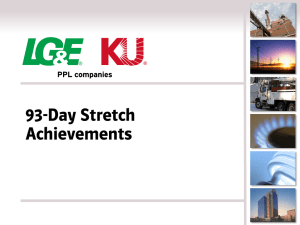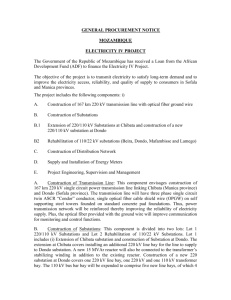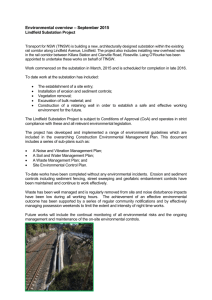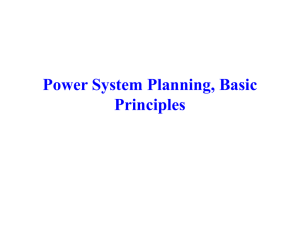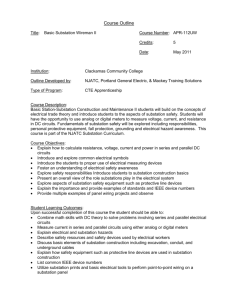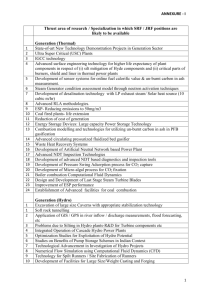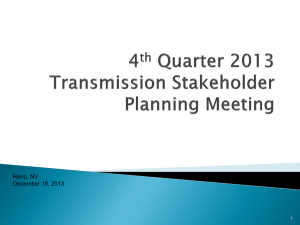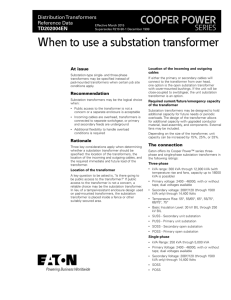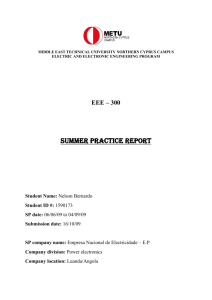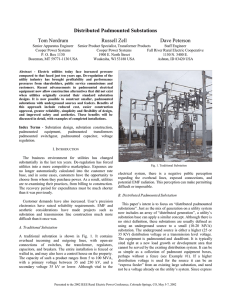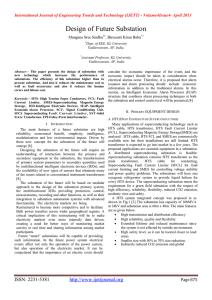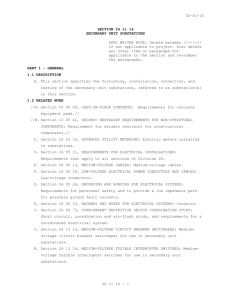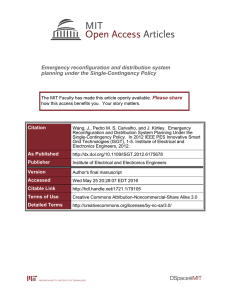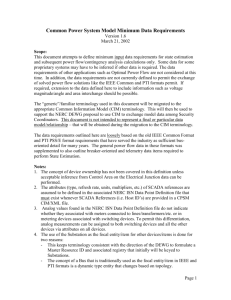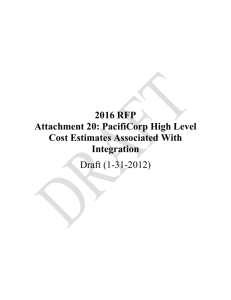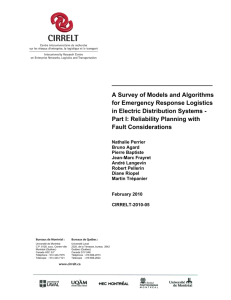Change Course APR 122UW Outline
advertisement
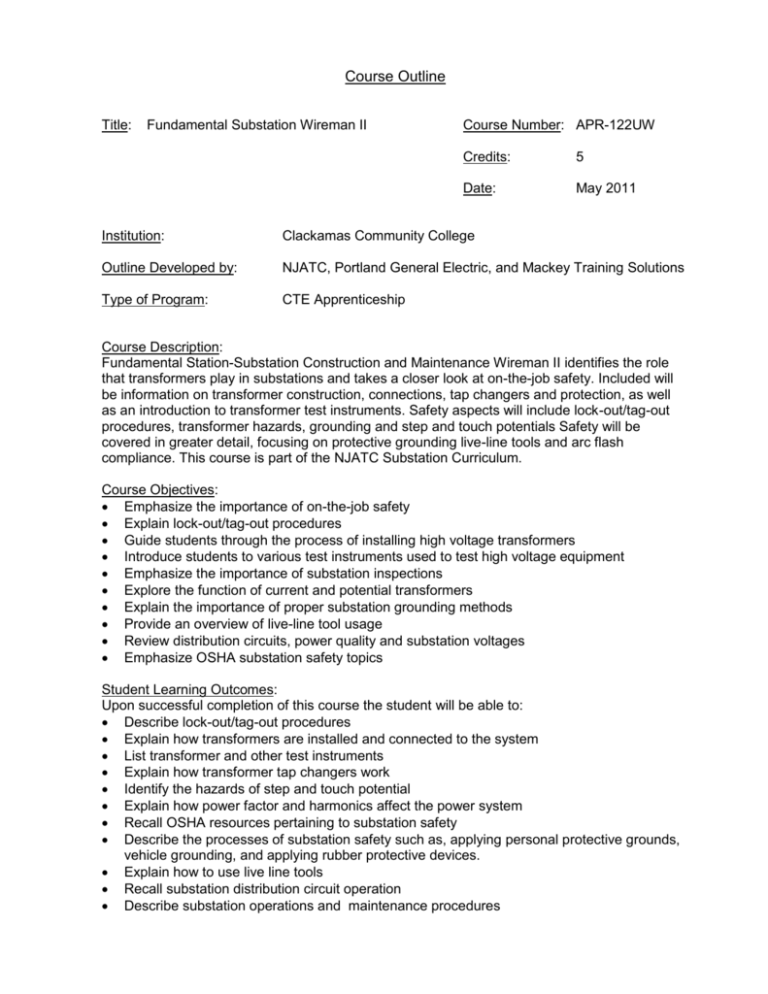
Course Outline Title: Fundamental Substation Wireman II Course Number: APR-122UW Credits: 5 Date: May 2011 Institution: Clackamas Community College Outline Developed by: NJATC, Portland General Electric, and Mackey Training Solutions Type of Program: CTE Apprenticeship Course Description: Fundamental Station-Substation Construction and Maintenance Wireman II identifies the role that transformers play in substations and takes a closer look at on-the-job safety. Included will be information on transformer construction, connections, tap changers and protection, as well as an introduction to transformer test instruments. Safety aspects will include lock-out/tag-out procedures, transformer hazards, grounding and step and touch potentials Safety will be covered in greater detail, focusing on protective grounding live-line tools and arc flash compliance. This course is part of the NJATC Substation Curriculum. Course Objectives: Emphasize the importance of on-the-job safety Explain lock-out/tag-out procedures Guide students through the process of installing high voltage transformers Introduce students to various test instruments used to test high voltage equipment Emphasize the importance of substation inspections Explore the function of current and potential transformers Explain the importance of proper substation grounding methods Provide an overview of live-line tool usage Review distribution circuits, power quality and substation voltages Emphasize OSHA substation safety topics Student Learning Outcomes: Upon successful completion of this course the student will be able to: Describe lock-out/tag-out procedures Explain how transformers are installed and connected to the system List transformer and other test instruments Explain how transformer tap changers work Identify the hazards of step and touch potential Explain how power factor and harmonics affect the power system Recall OSHA resources pertaining to substation safety Describe the processes of substation safety such as, applying personal protective grounds, vehicle grounding, and applying rubber protective devices. Explain how to use live line tools Recall substation distribution circuit operation Describe substation operations and maintenance procedures Length of Course: 55 lecture hours Grading Method: Letter grade (A-F) or Pass/No Pass Prerequisites: Pass APR-121UW Major Topic Outline: UNIT 2-5 Safety Awareness – On the Job Lock-Out /Tag-Out - Substation Applications Introduction to Transformers Transformer Construction Vectors Transformer Operation Transformer Polarity/Connections Tap Changers and Tap Changer Operation Installing Transformers Single-Phase Transformer Connections Transformer Protection Introduction to Test Instruments General Use Test Instruments UNIT 2-6 Conducting Transformer Load Checks Transformers – Three-Phase Connections Transformers – Three-Phase Voltages Transformer theory for line Specific Hazards Working with Transformers Ferroresonance Transformation for Lineworkers Grounding in Substations Step and Touch Potential Equipotential Zone Grounding Testing Ground (Earth) Resistance Substation walk through inspections Substation CTs and PTs Power Factor Power Harmonics Unit 3-2 OSHA 1910.269 (u) (Substations) Arc Flash Compliance Temporary Grounding for Substations Induced Voltages and Multiple Grounds Selection of Equipment and Installation of Grounds Grounding Applying Rubber Protective Devices Live Line Tools – Introduction, Identification, and Care Line Tools – Using Hot Sticks Power Quality Substation Voltages Distribution Circuits Overview Substations – Operations and Maintenance Safety in Substations and Switchyards CCC AAOT/ASOT GENERAL EDUCATION OUTCOMES COURSE OUTLINE MAPPING CHART Course Title and Number: APR-122UW Fundamental Substation Wireman II Mark outcomes addressed by this course: Mark “C” if this course completely addresses the outcome. Students who successfully complete this course are likely to have attained this learning outcome. Mark “S” if this course substantially addresses the outcome. More than one course is required for the outcome to be completely addressed. Students who successfully complete all of the required courses are likely to have attained this learning outcome. Mark “P” if this course partially addresses the outcome. Students will have been exposed to the outcome as part of the class, but the class is not a primary means for attaining the outcome and assessment for general education purposes may not be necessary. As a result of completing the AAOT /ASOT general education requirements, students will be able to: WR: Writing Outcomes 1. Read actively, think critically, and write purposefully and capably for academic and, in some cases, professional audiences. 2. Locate, evaluate, and ethically utilize information to communicate effectively. 3. Demonstrate appropriate reasoning in response to complex issues. SP: Speech/Oral Communication Outcomes 1. Engage in ethical communication processes that accomplish goals. 2. Respond to the needs of diverse audiences and contexts. 3. Build and manage relationships. MA: Mathematics Outcomes 1. Use appropriate mathematics to solve problems. 2. Recognize which mathematical concepts are applicable to a scenario, apply appropriate mathematics and technology in its analysis, and then accurately interpret, validate, and communicate the results. AL: Arts and Letters Outcomes i 1. Interpret and engage in the Arts & Letters, making use of the creative process to enrich the quality of life. 2. Critically analyze values and ethics within a range of human experience and expression to engage more fully in local and global issues. SS: Social Science Outcomes 1. Apply analytical skills to social phenomena in order to understand human behavior. 2. Apply knowledge and experience to foster personal growth and better appreciate the diverse social world in which we live. SC: Science or Computer Science Outcomes 1. Gather, comprehend, and communicate scientific and technical information in order to explore ideas, models, and solutions and generate further questions. 2. Apply scientific and technical modes of inquiry, individually, and collaboratively, to critically evaluate existing or alternative explanations, solve problems, and make evidence-based decisions in an ethical manner. 3. Assess the strengths and weaknesses of scientific studies and critically examine the influence of scientific and technical knowledge on human society and the environment. CL: Cultural Literacy Outcomeii 1. Identify and analyze complex practices, values, and beliefs and the culturally and historically defined meanings of difference. IL: Information Literacy Outcomesiii 1. Formulate a problem statement. 2. Determine the nature and extent of the information needed to address the problem. 3. Access relevant information effectively and efficiently. 4. Evaluate information and its course critically. 5. Understand many of the economic, legal, and social issues surrounding the use of information. P P P P P P P P P P P P P P P “Arts and Letters” refers to works of art, whether written, crafted, designed, or performed and documents of historical or cultural significance. Must be embedded in a course that meets the outcomes for Arts and Letters, Social Science, or Science/Computer Science. iii Must be embedded in the general education required Writing courses. Revised 2010-2011 to reflect Statewide AAOT outcomes i ii


